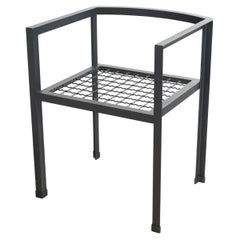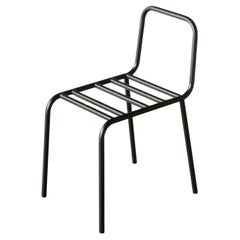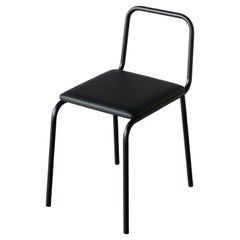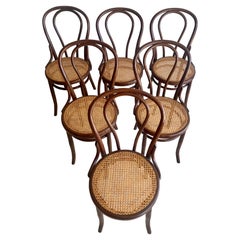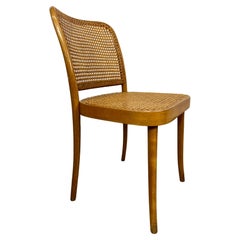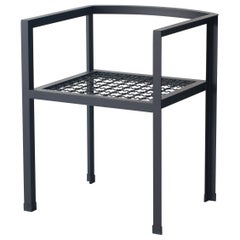Comme des Garçons Seating
Comme des Garçons is one of the world’s most innovative and trailblazing fashion brands, helmed by its inimitable founder, Japanese designer Rei Kawakubo (b. 1942), who has a penchant for breaking fashion and cultural norms. The only living designer apart from Yves Saint Laurent to have a retrospective at the Metropolitan Museum of Art’s Costume Institute, Kawakubo has permanently changed fashion with designs that challenge traditional ideas of beauty with a creative and transgressive exuberance.
After studying art and literature at Keio University in Tokyo, Kawakubo worked as a freelance stylist before establishing her own label in 1969. Comme des Garçons — which is also known as CDG — officially launched in 1973, and Kawakubo opened her first store in Tokyo three years later. She has since been instrumental in pioneering many concepts now familiar in contemporary fashion.
One of Kawakubo's most iconic moves was her introduction of androgynous styles (Comme des Garçons means “like the boys” in French) with asymmetrical, twisted silhouettes that envelope the body. While she told the New York Times that the “basics of clothing lie in men’s fashion,” Kawakubo believes in the concept of humanness in clothes (she titled her spring 1995 show “Transcending Gender”).
In the 1970s, when color-blocking was the norm, Kawakubo stuck to her monochromatic color palette dominated by shades of black with uncompromising dedication, although with evocative and powerful use of red and white.
Comme des Garçons is also known for an often shocking take on fashion. Deconstructed tailoring, violently slashed fabric and sculptural shapes are some themes that run through the brand’s collections, but Kawakubo never explains the meaning of her conceptual pieces, which fall somewhere between art and fashion.
Designer Junya Watanabe, who worked alongside Kawakubo for nearly a decade, operates an atelier based within the Tokyo headquarters of Comme des Garçons, and he established a line under Kawakubo's label in the early 1990s. Since then, even though the brand has launched additional lines and more commercial offshoots like PLAY, known by the iconic heart motif with eyes, the premier men’s line Homme Plus and the multilabel Dover Street Market that opened in 2004, the essence of Comme des Garçons remains Kawakubo’s otherworldly and undefinable creations, which are impossible to ignore.
Find vintage Comme des Garçons shirts, jackets, day dresses and other clothing on 1stDibs.
1980s Japanese Minimalist Vintage Comme des Garçons Seating
Steel
1980s Japanese Minimalist Vintage Comme des Garçons Seating
Steel
1980s Japanese Minimalist Vintage Comme des Garçons Seating
Steel
Mid-20th Century Polish Mid-Century Modern Comme des Garçons Seating
Cane, Wood
1930s Czech Bauhaus Vintage Comme des Garçons Seating
Rattan, Beech, Bentwood
21st Century and Contemporary Turkish Modern Comme des Garçons Seating
Upholstery, Foam, Walnut
21st Century and Contemporary Turkish Modern Comme des Garçons Seating
Upholstery, Foam, Beech
1980s Hungarian Jugendstil Vintage Comme des Garçons Seating
Fabric, Bentwood
Early 1900s Czech Vienna Secession Antique Comme des Garçons Seating
Rattan, Bentwood
Early 1900s Austrian Vienna Secession Antique Comme des Garçons Seating
Beech, Bentwood
2010s Mexican Mid-Century Modern Comme des Garçons Seating
Leather, Fabric, Walnut
1940s Czech Art Deco Vintage Comme des Garçons Seating
Wood, Beech
Early 1900s Austrian Vienna Secession Antique Comme des Garçons Seating
Beech, Bentwood
Late 18th Century Austrian Art Nouveau Antique Comme des Garçons Seating
Upholstery, Wood, Fabric
2010s Norwegian Comme des Garçons Seating
Polystyrene, Wood
1980s Japanese Minimalist Vintage Comme des Garçons Seating
Steel
1980s Japanese Minimalist Vintage Comme des Garçons Seating
Steel
1980s Japanese Minimalist Vintage Comme des Garçons Seating
Steel
Comme Des Garçons seating for sale on 1stDibs.
- Is Commes des Garçons worth it?1 Answer1stDibs ExpertOctober 30, 2024Many fashion lovers believe that Commes des Garçons is worth it. Comme des Garçons is one of the world’s most innovative and trailblazing fashion brands, helmed by its inimitable founder, Japanese designer Rei Kawakubo, who has a penchant for breaking fashion and cultural norms. The only living designer apart from Yves Saint Laurent to have a retrospective at the Metropolitan Museum of Art’s Costume Institute, Kawakubo has permanently changed fashion with designs that challenge traditional ideas of beauty with creative and transgressive exuberance. However, whether or not it’s worth investing in Commes des Garçons pieces is totally subjective! At 1stDibs, we believe in buying what you love. Our shopping experience enables discovery and learning, whether you are a seasoned connoisseur or just beginning your collection. Find Commes des Garçons pieces and other apparel and accessories for sale on 1stDibs.
- 1stDibs ExpertJanuary 10, 2025The meaning behind Comme des Garçons relates to the signature style the brand's founder, Rei Kawakubo, is known for. In French, the brand's name means "like the boys." It relates to Kawakubo's androgynous styles with asymmetrical, twisted silhouettes that envelope the body. While she once told the New York Times that the “basics of clothing lie in men’s fashion,” Kawakubo believes in the concept of humanness in clothes (she titled her spring 1995 show “Transcending Gender”). On 1stDibs, shop a selection of Comme des Garçons apparel and accessories.
